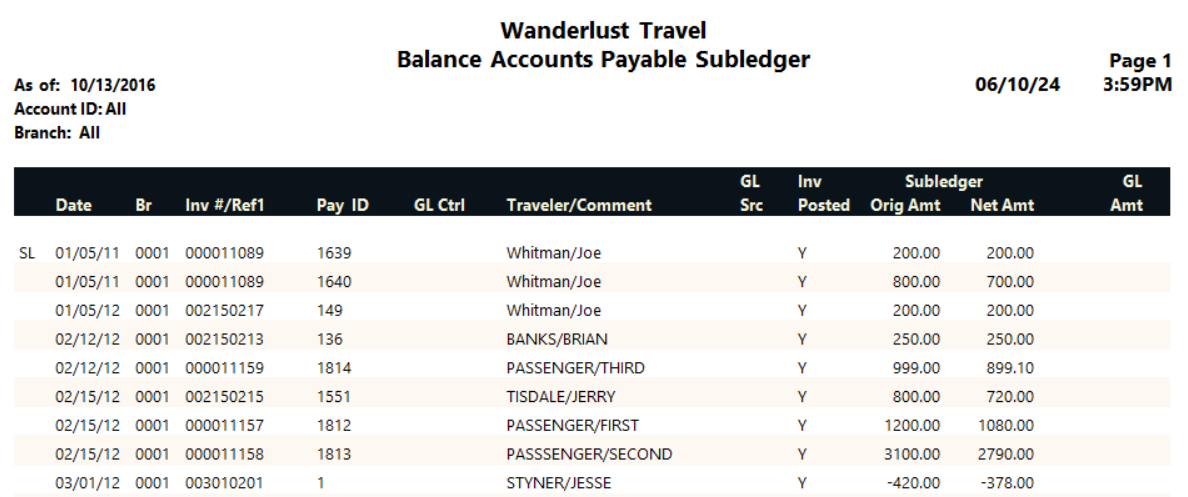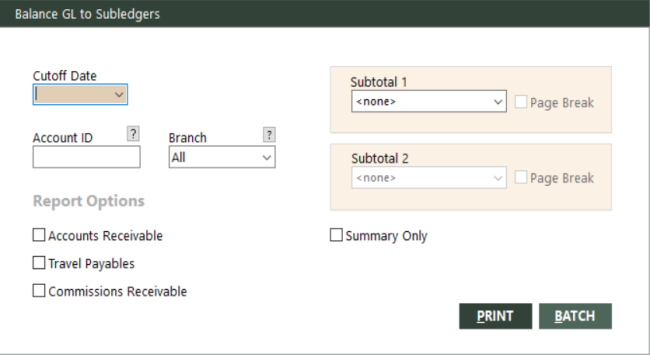Balance GL to Subledgers
The subledgers consist of the agency’s invoices, checks, receipts, and adjustments. The balance in each subledger should always balance with the equivalent charts in the general ledger.
This report compares the balances in the subledgers and general ledger to see if they balance. General ledger accounts that are out of balance with the subledger are indicated with an asterisk on the reports.
All open items are included on the report. To reduce the volume of data on the report, apply subledger items and close general ledger items as much as possible before running the report. Use the Adjust Accounts function to apply subledger items. For details, see Adjust Accounts Overview. Use the Automatic Reconciliation and Manual Reconciliation functions to close general ledger items. For details, see Automatic Reconciliation and Manual Reconciliation.
For more information related to this topic, see Balancing Subledgers to General Ledger.
Warning: On the System Tab in the Post Invoices By option, if an option other than A/R Date is selected, balancing subledgers to GL is more complex. GlobalWare standard reports have not yet been enhanced to support options other than A/R Date. You must create custom reports and processes in order to balance subledgers to GL if another option is selected.
Accounts Receivable
Subledger accounts receivable items include the following:
-
Invoice items with form of payment (FOP) R (receivables), C (cash), and A (agency plastic).
If you are on cash-basis accounting, only invoice items with settlement type A (ARC) or D (direct) are in the accounts receivable subledger.
- Cash receipts, checks, and adjustments for customer, employee, and vendor accounts.
Only open items (customer received amount not equal to customer due amount) are included on the report.
General ledger receivable items include the following:
- Items posted to the accounts receivable charts. These all are general ledger customer charts in the processing table (usually 1510) except for the general ledger customer charts for tracking items (9999) and Group, ARC, Air included (usually 2520).
- Items posted to the customer unapplied funds chart (usually 2040), gift certificate chart (usually 2050), and layaway chart (usually 2055).
Only open items (GL Status equals "O") are included on the report.
Accounts Payable
Subledger accounts payable items include the following:
- Invoice items with sale type R (retail), settlement I (invoice), and FOP R, C, or A.
- Invoice items with sale type G (group), settlement I, and FOP P (plastic).
- Cash receipts, checks, and adjustments for provider accounts.
Only open items (provider paid amount not equal to provider due amount) are included on the report.
If you are on cash-basis accounting, retail invoice items appear if either the customer has paid or the provider has been paid. They are excluded if both have paid in full or neither have paid at all. These items appear if either the provider paid date or customer received date is on or before the cut-off date.
General Ledger receivable items include the following:
- Items posted to the accounts payable charts. These are all general ledger provider charts in the processing table for Retail, Invoice (usually 2020).
- Items posted to the provider unapplied funds chart (usually 2045).
Only open items are included on the report.
Commissions Receivable
In accrual accounting, subledger commission receivable items include the following:
- Invoice items with sale type R, settlement I, and FOP P.
Only open items (commission received amount not equal to commission due amount) are included on the report.
General ledger receivable items include the following:
- Items posted to the commissions receivable chart (usually 1512).
Only open items are included on the report.
If you are on cash-basis accounting, the commissions receivable report is not available because commissions for plastic items do not create a receivable in the general ledger.
Sorting and Subtotals
The reports subtotal on the general ledger chart. For subledger items, this is the chart the item posts to. Within the chart subtotal, the detail lines sort by subledger/general ledger, then date, then pay ID.
Outside of the chart subtotal, you have the option of subtotaling by account ID, branch, or both.
Running the Report
To run the report:
-
On the GL submenu, click Balance GL to Subledgers.
The Balance GL to Subledgers dialog box appears.
 Field descriptions
Field descriptions
The following table describes the fields on the Balance GL to Subledgers dialog box.
Field Description Cutoff Date
Enter the date through which you want items included on the report. Items that have a date that is up to or matches this date will be included on the report. This date is required.
Account ID
Full or partial customer account ID. Specify a full account ID to include information for this account ID only. Use the wildcard character (*) to specify a partial account ID, as shown in the following examples:
71*
Includes information for account IDs that begin with "71" (for example, "7126" and "7153").
*71
Includes information for account IDs that end with "71" (for example, "2071" and "10071").
*71*
Includes information for account IDs that contain "71" anywhere (for example, "7126", "10713", and "10071").
You can also specify @TAGGED to include information for tagged accounts only, or @ followed by a customer interest code (for example, @SKI) to include information for only accounts with that interest.
Leave this field blank to include information for all customers.
To find and select a customer account ID, click the lookup (
 ) button. The Find an Account ID screen appears. For details, see Using the Lookup Buttons and Screens.
) button. The Find an Account ID screen appears. For details, see Using the Lookup Buttons and Screens.Branch
Branch or location group. The report will include items for this branch or location group only. Only those branches to which the user has access display. Select All to include items for all branches to which the user has access.
To find and select a branch or location group, click the lookup (
 ) button. The Find Branch screen appears. For details, see Using the Lookup Buttons and Screens.
) button. The Find Branch screen appears. For details, see Using the Lookup Buttons and Screens.Accounts Receivable
Indicates whether to run this report for account receivables.
Travel Payables
Indicates whether to run this report for travel payables.
Commissions Receivable
Indicates whether to run this report for commission receivables.
Subtotal 1
First-level field to use for subtotaling report data. The following fields are available from the drop-down list: Branch and Account Id. You can also select <none>.
Page Break (for subtotal 1)
Indicates whether to start new report pages for each subtotal, based on the field specified in Subtotal 1.
Subtotal 2
Second-level field to use for subtotaling report data. The following fields are available from the drop-down list: Branch and Account Id. You can also select <none>.
Page Break (for subtotal 2)
Indicates whether to start new report pages for each subtotal, based on the field specified in Subtotal 2.
Summary Only
Indicates whether to create a summary-only report. It includes only subtotals and totals.
-
Complete the fields as appropriate.
Note: The Cutoff Date field is required. You must also select at least one option under Report Options.
- Choose one of the following print options:
To print the report immediately, click PRINT.
The Send to dialog box appears. Select a report destination. For more information, see Printing Overview.
To store the report as part of a batch for printing later, click BATCH.
The Choose a Batch dialog box appears. For more information, see Batch Printing.
Report Example
Balance GL to Subledgers report example

Report Notes
SL/GL
The first column of the report indicates if the item is a subledger item (SL) or general ledger item (GL).
Date
The date on the subledger detail line if you are on accrual accounting is the accounts receivable due date because accounts receivable, accounts payable, and commissions receivable post on the accounts receivable due date.
The date if you are on cash-basis is the accounts receivable due date for the accounts receivable reports (even though the item actually posts on the settlement period end date). For the accounts payable report for invoice items, it is the provider paid date if there is one, or else the customer received date.
Amounts
The original amount on the report is the full, original customer/provider/commission due amount. The net amount is the original amount less any amount received.
For accounts payable invoice items if you are on accrual accounting, the net amount includes the commission. For example, for a $1000 item with $150 commission and $500 has been paid to the provider, the net amount is $350.
For accounts payable invoice items if you are on cash-basis accounting, the open provider amount is the original amount less any provider paid amount, the open customer amount is the original customer amount less any received amount, and the net amount is the open provider amount less the open customer amount.
The subledger total net amount should equal the general ledger total amount.
"Missing Account ID" or No Account Name for Account ID Subtotal
"Missing Account ID" indicates a general ledger transaction posted to a subledger chart with no value in the Ref 2 field (accounts receivable and accounts payable report) or Ref 3 field (commissions receivable report). No account name indicates a general ledger transaction posted to a subledger chart with an invalid account ID in the Ref 2 or Ref 3 field.
Out-of-Balance Conditions
All invoice items are included on the report regardless of the posting status. Unposted items cause an out of balance condition. Make sure you have posted items to the general ledger, using Post Invoices to GL (all accrual items and cash-basis group plastic items) or Settlement (cash-basis ARC and Direct receivable items) before attempting to balance that date.
If items that occurred on or before the cut-off date are applied after the cut-off date, the report is out of balance. For example, a ticket was issued for $500 on 1/30, the receipt for $500 entered and applied on 2/2, and the report printed as of 1/31. The subledger subtotal shows zero (because the items have been applied) and the general ledger subtotal is $500 (it includes the ticket amount but not the receipt).
Items posted directly to the subledger charts (1510, 2040, and so forth) cause an out of balance condition. You should not post to the subledger charts in Journal Entries, Post Deposit receipt to GL, Write Checks check to GL, or as the offset for an adjustment in Adjust Accounts.
Items that should have posted to a subledger account but did not because of an error post to chart 9999. Until these are corrected, the chart is out of balance.
General ledger items that have been closed without balancing might cause an out of balance condition.
In cash-basis accounting, if a receivable item’s accounts receivable due date is on or before the cut-off date but the actual settlement period end date is after the cut-off date, the chart is out of balance.
